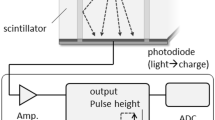Abstract
Purpose
Conventional X-ray CT scanners have limited ability to distinguish low-contrast substances. However, spectral CTs with photon counting detectors can identify photon energy and utilize spectral information, which is expected to achieve improved contrast. Energy weighting is a kind of reconstruction method for spectral CT. By assigning appropriate weight for each energy channel, the image contrast can be improved. Hence, how to determine the optimal weights is very important.
Methods
In this paper, we developed an improved projection-based energy weighting model for spectral CT. In this model, the object thickness of low-density materials is assumed as a constant, and the measured spectrum distribution is used to calculate the weight coefficients. Both phantom and tissue experiments were conducted in spectral CT scanner.
Results
The results showed that the thickness of low-density materials has little influence on the energy weight, so it can be regarded as a constant. For low-contrast phantom, the contrast-to-noise ratio was improved ~ 32% by the proposed projection-based weighting method.
Conclusions
The improved projection-based energy weighting model is effective in practice. It can increase the contrast of low-density materials.














Similar content being viewed by others
References
P.M. Shikhaliev et al., Computed tomography with energy-resolved detection: a feasibility study. Phys. Med. Biol. 53, 1475–1495 (2008)
D. Niederlohner et al., Practical aspects of energy weighting in X-ray imaging. IEEE Nucl. Sci. Symp. Conf. Record. 5, 3191–3194 (2004)
H.Q. Le et al., Radiation dose reduction using a CdZnTe-based computed tomography system: comparison to flat-panel detectors. Med. Phys. 37, 1225–1236 (2010)
C. Reinhart et al., Experimental simulation of a spectroscopic pixel X-ray detector. Nucl. Instrum. Methods A 546, 205–208 (2005)
P.M. Shikhaliev, Projection X-ray imaging with photon energy weighting: experimental evaluation with a prototype detector. Phys. Med. Biol. 54, 4971–4992 (2009)
K.S. Kalluri et al., Investigation of energy weighting using an energy discriminating photon counting detector for breast CT. Med. Phys. 40, 081923 (2013)
Sung-Hoon Choi et al., Projection-based energy weighting on photon-counting X-ray images in digital subtraction mammography: a feasibility study. SPIE Med. Imaging 9033, 90334B (2014)
P.M. Shikhaliev, Beam hardening artefacts in computed tomography with photon counting, charge integrating and energy weighting detectors: a simulation study. Phys. Med. Biol. 50, 5813–5827 (2005)
P.M. Shikhaliev, Photon counting spectral CT versus conventional CT: comparative evaluation for breast imaging application. Phys. Med. Biol. 56, 1905–1930 (2011)
T.G. Schmidt, Optimal “image-based” weighting for energy-resolved CT. Med. Phys. 36, 3018–3027 (2009)
R.A. Brooks et al., Statistical limitations in X-ray reconstructive tomography. Med. Phys. 3, 237–240 (1976)
M.J. Tapiovaara et al., SNR and DQE analysis of broad spectrum X-ray imaging. Phys. Med. Biol. 30, 519–529 (1985)
P.M. Shikhaliev, Computed tomography with energy-resolved detection: a feasibility study. Phys. Med. Biol. 53, 1475–1495 (2008)
K.S. Kalluri et al., Investigation of energy weighting using an energy discriminating photon counting detector for breast CT. Med. Phys. 40, 081923 (2013)
X-ray Mass Attenuation Coefficients (2004). https://www.nist.gov/pml/X-ray-mass-attenuation-coefficients. Accessed 12 Oct 2018
D. Niederlohner et al., The energy weighting technique: measurements and simulations. Nucl. Instrum. Methods A 546, 37–41 (2005)
Ruizhe Li et al., Spectrum reconstruction method based on the detector response model calibrated by X-ray fluorescence. Phys. Med. Biol. 62, 1032–1045 (2017)
Acknowledgements
This work is supported by the National Key R&D Program of China (Grant No. 2016YFC0100400, Ministry of Science and Technology of the People’s Republic of China), the Instrument Developing Project of the Chinese Academy of Sciences (Grant No. YZ201511), the Key Technology Research and Development Team Project of Chinese Academy of Sciences (Grant No. GJJSTD20170005).
Author information
Authors and Affiliations
Corresponding author
Rights and permissions
About this article
Cite this article
Cheng, Z., Li, M., Xu, Q. et al. Improved projection-based energy weighting for spectral CT. Radiat Detect Technol Methods 3, 28 (2019). https://doi.org/10.1007/s41605-019-0106-2
Received:
Revised:
Accepted:
Published:
DOI: https://doi.org/10.1007/s41605-019-0106-2




